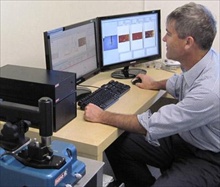Members Login

Channels
Special Offers & Promotions
Leading researchers publish keynote paper applying AFM-IR to better understand polymer crystallization processes on the sub-micron length scale
 Anasys Instruments'
AFM-IR system is featured in a new keynote publication in this month's issue of
Applied Spectroscopy: Spatial Differentiation of Sub-Micrometer domains in a
Poly(hydroxyalkanoate) copolymer using instrumentation that combines Atomic
Force Microscopy (AFM) and Infrared (IR) Spectroscopy.
Anasys Instruments'
AFM-IR system is featured in a new keynote publication in this month's issue of
Applied Spectroscopy: Spatial Differentiation of Sub-Micrometer domains in a
Poly(hydroxyalkanoate) copolymer using instrumentation that combines Atomic
Force Microscopy (AFM) and Infrared (IR) Spectroscopy. Leading materials scientist, Isao Noda of Procter & Gamble, and spectroscopist, Curtis Marcott of Light Light Solutions, in conjunction with the development and applications team from Anasys Instruments, have recently had their ground-breaking work on the characterization of sub-micron polymer domains using AFM-IR published in the October issue of Applied Spectroscopy, a leading applications journal published monthly by the Society for Applied Spectroscopy.
The paper highlights the combination of Atomic force microscopy (AFM) and infrared (IR) spectroscopy in a single instrument (AFM-IR) that is capable of producing sub-micrometer spatial resolution IR spectra and absorption images. This new technique enables the spectroscopic characterization of microdomain-forming polymers at levels not previously accessible.
The system employs a tunable IR laser generating pulses of the order of 10ns to excite polymer films which have been cast onto zinc selenide prisms. Short duration thermomechanical waves resulting from infrared absorption and corresponding thermal expansion were studied by monitoring the resulting excitation of the contact resonance modes of the AFM cantilever which in turn enables the resolution of crystalline microdomains of different sizes.
The AFM-IR shows clear and sharp spectra revealing important sub-micron information about the samples, particularly in the differences between amorphous and crystalline regions. Importantly, it is now possible to monitor the development of polymer crystalline structures at varying distances from a nucleation site, where the site was generated by bringing a heated AFM tip close to a specific location to locally anneal the sample.
The paper reports on a wealth of new information now available to the researcher. For example, an AFM image collected with the laser tuned at 1276 cm?¹ shows the distribution of the different microdomain structures. Then, by collecting spectra at 200 nm increments starting from a nucleation site (generated via heating with a nanoscale thermal probe), it becomes possible to gain insights into the crystallization mechanism of polymer systems.
Potential nanoIR application areas include polymer blends, multilayer films and laminates, organic defect analysis, tissue morphology and histology, subcellular spectroscopy, and organic photovoltaics.
For further details, please visit www.anasysinstruments.com.
Reference: "Spatial Differentiation of Sub-Micrometer Domains in a Poly(hydroxyalkanoate) Copolymer Using Instrumentation that Combines Atomic Force Microscopy (AFM) and Infrared (IR) Spectroscopy," Curtis Marcott, Michael Lo, Kevin Kjoller, Craig Prater, and Isao Noda. Applied Spectroscopy, Volume 65, Number 10, 2011.
Media Partners


